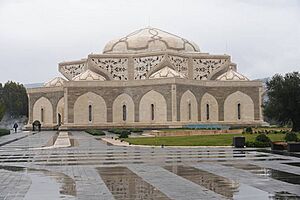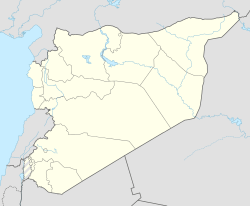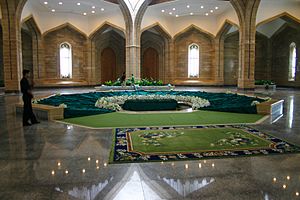Qardaha facts for kids
Quick facts for kids
al-Qurdaha
القَرْدَاحَة
|
|
|---|---|
|
Town
|
|

Mausoleum of Hafez al-Assad
|
|
| Country | |
| Governorate | Latakia |
| District | Qardaha |
| Subdistrict | Qardaha |
| Elevation | 420 m (1,380 ft) |
| Population
(2004)
|
|
| • Total | 8,671 |
| Time zone | UTC+2 (EET) |
| • Summer (DST) | UTC+3 (EEST) |
Qardaha (Arabic: القَرْدَاحَة) is a town in northwestern Syria. It is located in the mountains, high above the coastal city of Latakia. Other towns nearby include Kilmakho to the west and Muzayraa to the north. In 2004, Qardaha had about 8,671 people living there.
Most people in Qardaha are Alawites. This town is also the traditional home of the al-Assad family. This family has been important in leading Syria since the 1970s.
Syrian President Hafez al-Assad was born in Qardaha. He led Syria from 1970 to 2000. During his time, the government invested a lot of money in Qardaha, Latakia, and the areas around them. Qardaha has many fancy houses. You can find a large statue of Hafez al-Assad in the town center. There is also a huge building called a mausoleum where Bassel al-Assad and Hafez al-Assad are buried.
Climate and Geography of Qardaha
Qardaha has a hot-summer Mediterranean climate. This means it has hot, dry summers and mild, wet winters. Even though it's in the mountains, its height above sea level is not extremely high, usually between 350 and 500 meters.
Qardaha is in a beautiful area with many forests. It gets a lot of rain. In July, the average high temperature is about 29 °C (84 °F). In January, the average high is around 7 °C (45 °F). The town gets about 828 mm (32.6 inches) of rain each year. It also snows for about three days in January.
The good climate and nature in Qardaha are great for farming. Farmers grow apples, oranges, and tobacco there.
| Climate data for Qardaha | |||||||||||||
|---|---|---|---|---|---|---|---|---|---|---|---|---|---|
| Month | Jan | Feb | Mar | Apr | May | Jun | Jul | Aug | Sep | Oct | Nov | Dec | Year |
| Mean daily maximum °C (°F) | 7 (45) |
11 (52) |
15 (59) |
19 (66) |
24 (75) |
28 (82) |
29 (84) |
28 (82) |
26 (79) |
23 (73) |
17 (63) |
10 (50) |
20 (68) |
| Daily mean °C (°F) | — | — | — | — | — | — | — | 28 (82) |
— | — | — | — | — |
| Mean daily minimum °C (°F) | 3 (37) |
6 (43) |
6 (43) |
8 (46) |
13 (55) |
17 (63) |
20 (68) |
20 (68) |
17 (63) |
15 (59) |
9 (48) |
5 (41) |
12 (53) |
| Average precipitation mm (inches) | 182 (7.2) |
119 (4.7) |
63 (2.5) |
40 (1.6) |
29 (1.1) |
6 (0.2) |
4 (0.2) |
1 (0.0) |
37 (1.5) |
79 (3.1) |
90 (3.5) |
178 (7.0) |
828 (32.6) |
| Average rainy days (≥ 1 mm) | 16 | 14 | 11 | 8 | 4 | 1 | 1 | 1 | 4 | 7 | 11 | 14 | 92 |
| Average snowy days (≥ 1 cm) | 3 | 1 | 0 | 0 | 0 | 0 | 0 | 0 | 0 | 0 | 0 | 1 | 5 |
Source #3 Climate Zone (Rainy and snowy days)
A Look at Qardaha's Past
According to old stories, the people of Qardaha came from a group of tribes called the Kalbiyya. Qardaha was their main meeting place.
During the time of the Ottoman Empire, between 1840 and 1880, there were often problems between the government and the Alawite tribes in the coastal mountains. In 1854, the Ottoman governor of the Latakia area was killed during a fight with a tribe from Qardaha. This made the Kalbiyya fighters more confident, and they started more attacks against Ottoman positions. The government responded very strongly.
Many Alawite farmers living near Qardaha chose not to live in big towns. They wanted to avoid the government's attention, taxes, and being forced to join the army. Even today, Qardaha is surrounded by many small, spread-out farming villages. Qardaha used to have a lot of Christian residents. However, most Christian families moved to bigger coastal cities in the mid to late 1900s.
In 1970, Qardaha became an official city, along with al-Shaykh Badr and Duraykish. These three towns made up about 6% of the city population in the Latakia and Tartus areas. These three towns also became the centers of new districts. Some experts believe that the government, which came to power in the 1960s, showed special favor to these three towns because they were Alawite, especially Qardaha. For example, some other areas with more people were not made into districts, while Qardaha and the other two towns, with fewer than 40,000 people, were.
In October 2012, during the Syrian civil war, there was a conflict in the town. Later, in April 2013, the village was attacked with rockets. In August 2013, rebel fighters moved closer to Qardaha, reaching a village about 20 kilometers (12 miles) away.
Images for kids




